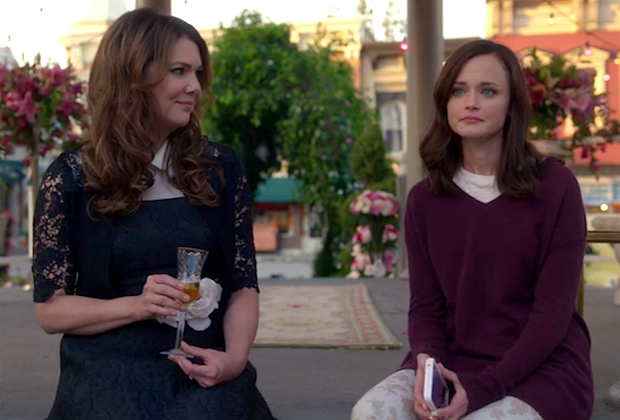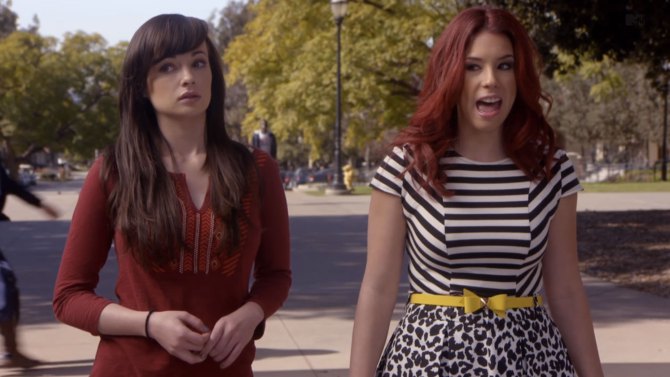Why Does Gilmore Girls Have a Monopoly on WB Nostalgia?
Written by Ian Thomas Malone, Posted in Blog, Pop Culture
Netflix offered millions of people a sanctuary from the Black Friday madness with the return of Gilmore Girls. The four episode limited revival has captured the interest of the pop culture world, bringing back the nostalgia of late 90s/early 00s WB programming. In an age with endless televisions offerings, both past and present, available to the consumer, it can be easy to forget that there once was a time when channels themselves were relevant at all, let alone ones that catered to a younger demographic.
With remakes and reboots popping up all over TV, it shouldn’t be surprising that Netflix wanted to book a return ticket to Stars Hollow. Gilmore Girls’ arrival to Netflix, relatively late to the streaming game in October 2014, garnered the kind of media attention that most current shows would kill for. What is perhaps surprising, is that Gilmore Girls is the only WB program to receive a revival in a world where Dynasty, Magnum P.I., and Prison Break are all being brought back to life. For a brief four month period, NBC wanted to capture the nostalgia of Coach before realizing that no one else did. So why is Gilmore Girls the only one of Michigan J. Frog’s offerings to return to millennial laptops, cell phones, and Apple TVs?
Gilmore Girls began its run right at the heart of WB’s love affair with the American youth. The show premiered in 2000, when Dawson’s Creek, 7th Heaven, Buffy the Vampire Slayer, Felicity were plastered all over the covers of teen magazines and the insides of high school lockers. As far as ratings success goes, Gilmore Girls maintained a comfortable viewership relative to the rest of the network, but consistently lagged behind 7th Heaven and Smallville with ratings comparable to Buffy and Everwood.
When you think about one sentence that fully encapsulates all the feels of The WB, is there any better the the opening lines, “I don’t want to wait, for our lives to be over,” bringing images of a quaint North Carolinian town to mind? I don’t think so. I wouldn’t hold your breath waiting for a Dawson’s Creek revival either. Poor Grams.
While ratings are nearly irrelevant in the year 2016 and shouldn’t be used as a barometer for the quality of a show, they do remind us that Gilmore Girls wasn’t even close to being the flagship program on the WB. It ended unremarkably in 2006 after a one season run on The CW without creator and writer extraordinaire Amy Sherman-Palladino. The unsatisfying ending serves as a potential explanation for the desire to seek additional episodes, but no such treatment has been given to Charmed, which fell victim to massive budget cuts in its ninth and final season. Joss Whedon directed two of the highest grossing movies of all time, yet there’s been almost no talk of any Buffy or Angel continuation.
Gilmore Girls remains on an island, or perhaps in a diner of its own in WB lore. With podcasts like “Gilmore Guys” breathing new life into the fandom years after its demise, there’s no doubt that the show maintains a cult status with its viewers that most shows would kill for. There’s little question that the show’s writing was among the best on TV even if the Emmys refused to acknowledge it. The show’s fast paced dialogue, filled with pop culture references, practically forces repeat viewing. It could be that Gilmore Girls is the only WB show to get a revival because it was the best show on the network. Problem is that doesn’t really explain the legions of revivals while plenty of other popular and beloved programs remain dormant. Is anyone really angling for another season of The Wire?
Melissa McCarthy’s recent A-list success is obviously part of the equation, but I hesitate to give it too much credit. Sookie may have been Lorelai’s best friend, but was still a supporting character on a similar level as Lane or Paris. McCarthy’s cameo is important to recapturing the magic of the show, but hardly a driving force in A Year in the Life.
The varying success of other WB stars fail to shed any consistent light on the lack of appeal for other shows either. Michelle Williams, Katie Holmes, Jessica Biel, Keri Russell, David Boreanaz, Alyson Hannigan and Emily VanCamp have all either been in big budget movies or hit series, but James van der Beek has, so far, been the only former WB star to try to cash in on his old nostalgic value. Putting aside 7th Heaven’s soiled reputation in the wake of Stephen Collins’ transformation from beloved father to pedophile, it does seem odd that no network or streaming service hasn’t tried to tap into the former magic of the WB besides Gilmore Girls.
We’ve seen plenty of articles and studies on pop culture’s recent obsession with nostalgia. South Park captured it best with its “member berries” that use nostalgic references to give characters warm feelings of security. The past itself is less important than the idea of returning to a simpler time.
The world of Stars Hollow gave Gilmore Girls a unique leg up in this regard. Every episode takes you to a special place filled with all the warm feelings of community and beloved culture. The WB gave teens a sense that someone out there was on their side. Gilmore Girls possessed a degree of separation with its emphasis on family and the town itself.
An image of Joey Potter climbing through Dawson Leery’s bedroom window might look a little creepy in the year 2016. The idea of Felicity as a grad student or college professor seems a bit odd, regardless of hairstyle. What would the Camdens have to lecture their kids about in a world with legalized pot? Stars Hollow survives because the idea is timeless in a world where the doors opened by technology often lead to divisiveness and isolation. The best revivals are the ones that don’t just recapture the magic, but bring something new to the table as well. For much of The WB’s roster, nostalgia is probably best left in the past.












